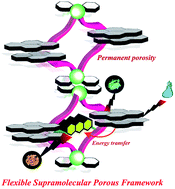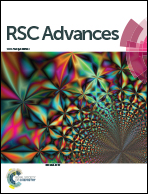Rational design of a pyrene based luminescent porous supramolecular framework: excimer emission and energy transfer†
Abstract
Here we report a rational design and synthesis approach to construct a porous luminescent supramolecular framework by modulating the spatial arrangement of aromatic linkers directed by coordination to a metal ion. A metal–organic complex, {Cd(oxo-pba)2(H2O)2}n (1) has been synthesized using a functionalized pyrene linker, 1-pyrene-γ-oxo-butyric acid (oxo-pba) and this structure is extended to a 2D supramolecular framework through non-covalent interactions. Using Zn(II) as a metal center we have also synthesized {[Zn(oxo-pba)2(bpy)]·4H2O}n (2), which has a similar chemical structure as compound 1, except 2,2′-bipyridine chelator occupies the positions of the coordinated water molecules. Further, compound 2 extends via several π–π and C–H⋯π interactions to form a 3D porous supramolecular structure as supported by CO2 (195 K) and different solvent vapour adsorption studies. Compounds 1 and 2 both show bright pyrene excimer emission. Furthermore, the porosity and aromatic π electron decorated pore surface of compound 2 has been exploited for noncovalent encapsulation of a suitable acceptor dye acridine orange (AO) and an efficient energy transfer from the framework to encapsulated dye was observed.


 Please wait while we load your content...
Please wait while we load your content...